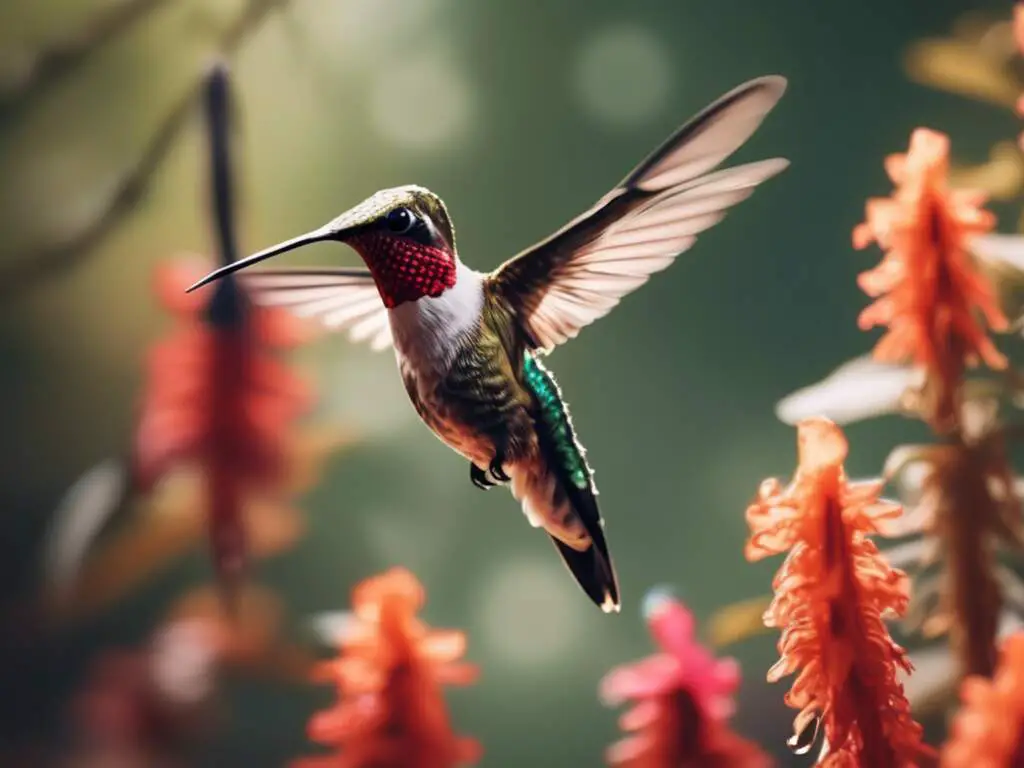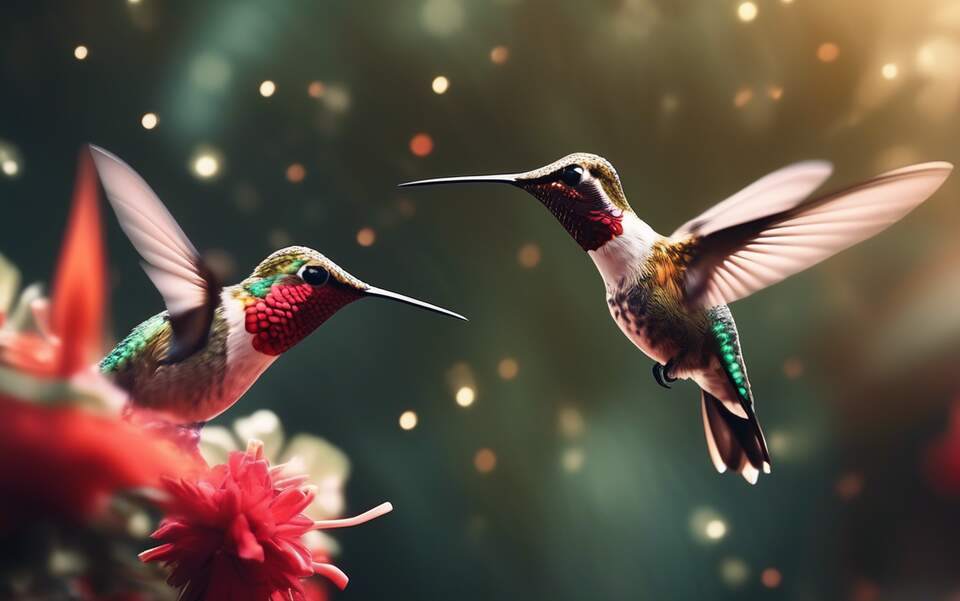Hummingbirds are fascinating and beautiful creatures that bring joy to any yard they visit. However, there are certain factors that can scare these delicate birds away from your yard. By understanding what these factors are and taking the necessary steps to address them, you can create a welcoming environment that will attract hummingbirds and keep them coming back.
Table of Contents
What Scares Hummingbirds Away?
1. Loud noises:
Hummingbirds are easily startled by loud noises such as barking dogs, lawnmowers, or construction work. Try to minimize noise in your yard, especially during the peak hummingbird season.
2. Sudden movements:
Quick movements or sudden gestures can scare hummingbirds away. Be mindful of your actions when you’re near a hummingbird feeder or flower garden.
3. Predators:
Natural predators like cats, snakes, or larger birds can pose a threat to hummingbirds. Take measures to deter these predators from your yard to create a safer environment for the hummingbirds.
4. Bright colors:
While hummingbirds are attracted to bright colors, overly bright or flashy objects can startle them. Opt for more natural and subtle colors in your yard decor.
5. Erratic behavior:
Avoid making sudden or erratic movements around hummingbirds. Try to move calmly and predictably to avoid scaring them off.
6. Dirty feeders:
Hummingbirds are meticulous creatures and do not appreciate dirty or moldy feeders. Keep your feeders clean and regularly change the nectar to avoid contamination.
7. Lack of shelter:
Hummingbirds need places to rest and take cover. Planting shrubs or installing perches in your yard can provide shelter for these tiny birds.
8. Strong scents:
Fragrant flowers or strong scents from perfumes, candles, or cleaners can be overwhelming for hummingbirds. Opt for unscented products in your yard.
9. Presence of other aggressive birds:
Bullying birds like jays or sparrows can intimidate hummingbirds. Try to discourage aggressive bird behavior in your yard.
10. Insecticides and pesticides:
Chemicals used in insecticides and pesticides can be harmful to hummingbirds. Opt for natural alternatives to keep your yard free of pests without posing a threat to these beautiful birds.
By being mindful of these 10 factors that can scare hummingbirds away from your yard, you can create a peaceful and inviting space that will attract these delightful creatures. With a few simple adjustments and precautions, you can enjoy the presence of hummingbirds in your yard and make it a welcoming haven for these tiny wonders of nature.
How to Create a Hummingbird-Friendly Environment in Your Garden?
Hummingbirds are delightful and enchanting creatures that can bring life and vibrancy to your garden. Creating a hummingbird-friendly environment in your garden is a rewarding endeavor that can attract these tiny wonders to visit regularly. By following some simple tips and guidelines, you can make your garden a haven for hummingbirds to enjoy.
Plant Native Flowers
Planting native flowers is an excellent way to attract hummingbirds to your garden. Hummingbirds are naturally drawn to the nectar-rich blossoms of native plants such as bee balm, columbine, and trumpet vine. These flowers provide a valuable food source for hummingbirds and will entice them to frequent your garden.
Provide a Water Source
In addition to nectar, hummingbirds need fresh water for drinking and bathing. A birdbath with a shallow basin or a dripping fountain can serve as a water source for hummingbirds. Make sure to clean the water source regularly to prevent the growth of harmful bacteria.
Use Bright Colors
Hummingbirds are attracted to bright colors, especially red, orange, and pink. Planting flowers with vibrant hues can catch the attention of hummingbirds and make your garden more inviting to them. Incorporate colorful garden decorations or feeders to further attract these tiny birds.
Hang Hummingbird Feeders
Hummingbird feeders are a popular way to supplement the nectar-producing flowers in your garden. Ensure the feeders have bright red accents to mimic the flowers that hummingbirds love. Make a sugar solution by mixing four parts water with one part white granulated sugar and fill the feeders regularly.
Provide Shelter and Resting Spots
Hummingbirds need places to rest and take shelter, especially during hot weather or storms. Planting trees and shrubs can offer protection and resting spots for hummingbirds. Consider adding perches or small roosting boxes in your garden for these tiny birds to rest.
Avoid Pesticides
Using pesticides in your garden can be harmful to hummingbirds and other wildlife. Opt for natural pest control methods or plant flowers that naturally repel pests. This will help create a safe and healthy environment for hummingbirds to thrive in.
Maintain a Clean Environment
Keeping your garden clean and well-maintained is essential for attracting hummingbirds. Remove any litter, debris, or clutter that may deter these birds from visiting. Regularly prune plants and flowers to ensure a tidy and welcoming space for hummingbirds.
Create a Variety of Heights
Hummingbirds prefer to feed at different heights, so it’s essential to have a variety of flowering plants at different levels in your garden. This diversity will cater to the varying flying and feeding habits of hummingbirds and make your garden more attractive to them.
Monitor and Enjoy
Once you have created a hummingbird-friendly environment in your garden, take the time to monitor and enjoy these fascinating creatures. Spend time observing their behavior, flight patterns, and interactions with other birds. Providing a hospitable space for hummingbirds can be a truly rewarding experience for any garden enthusiast.
By following these tips and guidelines, you can create a hummingbird-friendly environment in your garden that will attract these delightful creatures and provide them with the essential elements they need to thrive. With patience and dedication, you can transform your garden into a haven for hummingbirds to enjoy year-round.
Conclusion
As you work towards creating a hummingbird-friendly environment in your yard, it’s crucial to consider the various factors that may be deterring these delightful birds from visiting. By understanding the things that scare hummingbirds away and taking proactive steps to address them, you can attract these tiny wonders to your garden and enjoy their presence throughout the year.
In addition to eliminating potential threats and creating a safe space for hummingbirds, it’s essential to provide the necessary resources to ensure their well-being. Planting a diverse selection of native flowers and shrubs that offer nectar-rich blooms can help attract hummingbirds and provide them with a natural food source. Including a mix of colors, shapes, and sizes of flowers will appeal to these birds’ preferences and encourage them to frequent your garden.
Another key aspect of fostering a hummingbird-friendly environment is ensuring access to clean water for drinking and bathing. Installing a shallow birdbath or fountain with moving water can be particularly appealing to hummingbirds, as they are drawn to the sound and movement of water. Make sure to keep the water fresh and change it regularly to prevent the growth of harmful bacteria.
Creating sheltered areas in your garden, such as dense shrubs or trees, can provide hummingbirds with protection from predators and inclement weather. These sheltered spaces can also serve as resting spots for hummingbirds in between feeding flights, allowing them to conserve energy and feel secure in their surroundings.
Furthermore, minimizing the use of pesticides and herbicides in your yard can help create a safer environment for hummingbirds and other wildlife. Opt for natural or organic methods of pest control to avoid harmful chemicals that can be toxic to these tiny birds. By adopting sustainable gardening practices, you can promote a healthy ecosystem that benefits both hummingbirds and the environment as a whole.
By taking a holistic approach to creating a hummingbird-friendly environment in your garden, you can attract these fascinating creatures and enhance your outdoor space with their vibrant presence. From addressing potential threats to providing essential resources and implementing sustainable practices, there are many ways to make your yard a welcoming habitat for hummingbirds.
As you continue to learn more about these remarkable birds and their unique behaviors, you’ll discover new ways to support their well-being and create an inviting sanctuary that they will be drawn to. With patience, care, and a willingness to adapt your environment to their needs, you can enjoy the beauty and wonder of hummingbirds in your own backyard. Let your love for these tiny creatures inspire you to create a haven that beckons them to visit and thrive in the midst of your garden paradise.



